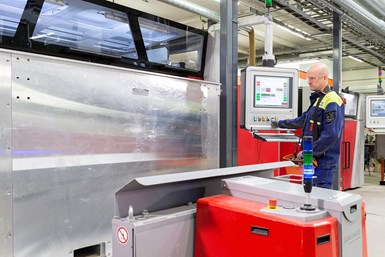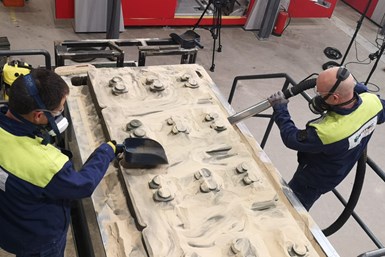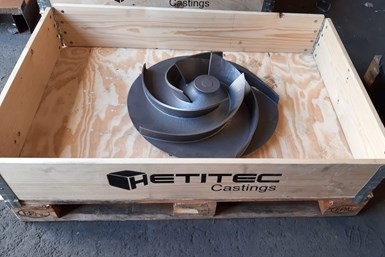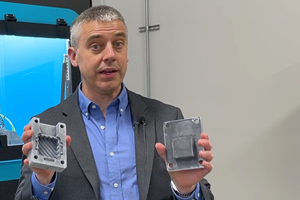Finland Sees Swifter Castings Through Hybrid Manufacturing
Combining sand 3D printing with casting has enabled Hetitec Oy to meet the underserved small-batch Finnish casting market — in some cases, producing high-priority parts in under a week.

After a process update, the VX2000 can print a full job box of 2 x 1 x 1 m in almost 24 hours. All images courtesy of Hetitec Oy.
Around 2008, Ville Mouilanen, then in charge of Voxeljet’s sales in the Scandinavian market, found the average casting delivery time in Finland was over three months — this, in spite of high demand from Finland’s industrial base in the mechanical engineering, energy supply and shipbuilding sectors. The Finnish foundry industry suffered from a lack of skilled foundry engineers at the time, with serial production through traditional methods keeping the engineers of the time busy.
These conditions inspired Moilanen to start Hetitec Oy, a center for 3D printing of sand molds and cores, in 2013. After several years working with a Voxeljet VX1000 to print furan molds and cores on demand for customers, he decided to scale up in 2018. He would build a foundry around his 3D printing capabilities and specialize in swift castings. This turned into “printed casting” — a hybrid manufacturing approach combining the geometric freedom of 3D printing and the cost benefits of conventional manufacturing.
New Capabilities with Printed Casting
Installation of Hetitec’s first round of casting equipment took place in early 2020. This included four melting furnaces that gave Hetitec the capability to melt steel (including duplex), grey iron, ductile iron (including ADI and SiMo) and aluminum. The foundry also invested in CAD software to avoid casting defects and keep the discharge rate as low as possible.
One more purchase was vital to this evolution: a VX2000 large-format printer from Voxeljet. This system’s build volume of 2 × 1 × 1 m supports the production of large individual molds or a variety of smaller components, depending on the requirements of the build.
“If it were up to our customers, they would prefer to have the castings yesterday,” Moilanen says. While 3D printing can’t go quite that far, a recent process update to the printer that improved its productivity by almost 40% means Hetitec can get close. “We can easily print one job box in less than a single day, which makes the VX2000 the most productive 3D printer in the whole of Finland. Given our equipment, we are able to produce casting sizes ranging from 1 – 600 kg within just a few days with a unique portfolio in terms of material diversity.”
Hetitec has partnered with nearby companies for machining and quality assurance. By doing so, it can proceed through its workflow to deliver finished parts within a week. As Moilanen puts it, “this makes us the fastest freaking foundry in the whole of Scandinavia.”

One of Hetitec’s claims to fame is that it constructed its foundry around 3D printing rather than integrating 3D printing into an existing foundry. This emphasis on 3D printing has granted the company the ability to produce and deliver finished castings within a week.
Tools Into Data
“In some cases, only a good 10% of all stored spare part patterns and molds are regularly retrieved and used in Finland,” Moilanen says. “The remaining 90% more or less just take up storage space.”
In addition to casting delivery times, this inventory space issue is one Moilanen hopes to solve with Hetitec’s 3D printing. Using modern scanning technology, the company can transform tool inventories into CAD files, which it can later retrieve from a “digital warehouse” to print and cast as needed. Hetitec hopes its success with this approach will expand the business and lead to further adoption of the process across Scandinavia.
Five Days, Not Five Months
Hetitec points to an example of its repair work for a broken-down icebreaker in Canada as representative of the company’s swiftness and flexibility.
Due to an engine defect, an icebreaker was stuck near the coast of Canada. The usual delivery time for the required component was around five months — a considerable financial problem for the owner. Swift availability of a spare part became the owner’s top priority, and the shipping line turned to Hetitec.
Hetitec was able to turn the 2D design of the spare part into a 3D CAD file within an hour. Production began on a Monday with the 3D printing of sand molds, and by that Friday, the machined and finished casting was on its way to Canada.

Spare parts and prototypes are specialties of Hetitec. As the Finnish casting industry is mainly focused on series production, small and medium orders are a largely untapped market in the region.
Printing Benefits, Casting Costs
Moilanen is confident about Hetitec’s future in the face of technologies like direct metal laser sintering (DMLS). At the sizes Hetitec often casts, current DMLS processes are prohibitively expensive. The price of sintering powders for aluminum are around €600 per kilogram and the price for certain steel alloys can run up to €1300 per kilogram, while aluminum alloys for casting only cost around €30 per kilogram. Metal casting also provides access to a larger selection of alloys at current, improving its ability to meet a wide range of customer requests.
Related Content
Additive Enhances Lost Foam Casting Process for Metal Manufacturing
Skuld LLC brings a new, 3D printing-enabled version of lost foam casting to market via its turnkey package for metal manufacturers. Additive Manufacturing Evaporative Casting (AMEC) enables metal parts made with sustainability and efficiency in mind.
Read MoreBPMI Chooses Velo3D Metal 3D Printing System to Produce Parts for U.S. Naval Nuclear Propulsion Program
The fully integrated 3D printing solution will be operated by ATI in a newly established facility that will provide the U.S. Naval Nuclear Propulsion Program with alternatives to cast parts.
Read MoreIn Casting and Molding, AM Simplifies Conventional Manufacturing
In new ways, additive processes are streamlining and enabling metal casting and plastic injection molding.
Read More3D Printing Solutions to Support Investment, Sand Casting
3D Systems is highlighting a design strategy for better investment casting patterns, as well as a new machine suitable for the production of patterns for sand casting.
Read MoreRead Next
Crushable Lattices: The Lightweight Structures That Will Protect an Interplanetary Payload
NASA uses laser powder bed fusion plus chemical etching to create the lattice forms engineered to keep Mars rocks safe during a crash landing on Earth.
Read MoreProfilometry-Based Indentation Plastometry (PIP) as an Alternative to Standard Tensile Testing
UK-based Plastometrex offers a benchtop testing device utilizing PIP to quickly and easily analyze the yield strength, tensile strength and uniform elongation of samples and even printed parts. The solution is particularly useful for additive manufacturing.
Read More3D Printed Polymer EOAT Increases Safety of Cobots
Contract manufacturer Anubis 3D applies polymer 3D printing processes to manufacture cobot tooling that is lightweight, smooth and safer for human interaction.
Read More




















